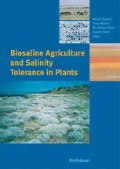Abstract
The major limiting factor on the expansion of irrigated agriculture throughout the world is the lack of water.Water demand is increasing due to fast population growth rates, improvement in living standards, improvement in industry and municipality, and global warming. Nowadays, there is an increasing tendency to use saline irrigation water in arid and semi-arid regions of the world because of rising water demands for irrigation. Slightly and moderately saline water can be used for irrigation successfully to grow salt tolerant and moderately salt-tolerant crops without adverse long-term effects on soil provided appropriate soil water management practices are followed [1].
Access this chapter
Tax calculation will be finalised at checkout
Purchases are for personal use only
Preview
Unable to display preview. Download preview PDF.
References
Katerji N, van Hoorn JW, Hamdy A, Mastrorilli M, Karam F (1998) Salinity and drought, a comparison of their effects on the relationship between yield and evapotranspiration. Agricultural Water Management 36: 45–54
Stewart JI, Danielson RE, Hanks RJ, Jackson EB, Hagan RM, Pruitt WO, Franklin W, Riley JP (1977) Optimizing crop production through control of water and salinity levels in the soil. Utah Water Research Lab. PR. 151-1, Logan, Utah, 191
Shalhevet J (1994) Using water of marginal quality for crop production: Major issues. Agricultural Water Management 25: 233–269
Shalhevet J, Hsiao TC (1986) Salinity and drought: A comparison of their effects on osmotic adjustment, assimilation, transpiration and growth. Irrig Sci 7: 249–264
Yamasaki S, Dillenburg LR(1999) Measurements of leaf relativewater content in araucaria angustifolia. Revista Brasilleira de Fisiologia Vegetal 11(2): 69–75
Maas EV, Hoffman GJ (1977) Crop salt tolerance-current. ASCE Journal of Irrigation and Drainage Division 103: 115–134
Sonneveld C, Voogt SJ (1978) Effects of saline water on glasshouse cucumber. Plant and soil 49: 595–606
Vulkan-Levy R, Ravina I, Mantell A, Frenkel H (1998) Effect of water supply and salinity on pima cotton. Agricultural Water Management 37: 121–132
Katerji N, van Hoorn JW, Hamdy A, Mastrorilli M (2004) Comparison of corn yield response to plant water stress caused by salinity and by drought. Agricultural Water Management 65: 95–101
Maggio A, Pascale SD, Angelino G, Ruggiero C, Barbieri G(2004) Physiological response of tomato to saline irrigation in long-term salinized soils. Eur J Agronomy 21: 149–159
Ayers RS, Westcot DW (1985) Water quality for agriculture. FAO Irrigation and drainage paper 29, Rome, 174
Chartzoulakis KS (1992) Effects of NaCI salinity on germination, growth and yield of greenhouse cucumber. J Horticultural Sci 67(1): 115–119
Bahceci I (1995) Evaluation of salinity-yield-applied irrigation water interactions for field bean under sprinkler irrigation method. Ph.D. dissertation, University of Cukurova, 109
Allen RG, Pereira LS, Raes D, Smith M (1998) Crop evapotranspiration. Guidelines for computing crop water requirements. FAO irrigation and drainage paper No 56, p301, FAO-Rome
Author information
Authors and Affiliations
Editor information
Editors and Affiliations
Rights and permissions
Copyright information
© 2006 Birkhäuser Verlag/Switzerland
About this paper
Cite this paper
Kirnak, H. (2006). Effects of irrigation water salinity on yield and evapotranspiration of drip irrigated cucumber in a semiarid environment. In: Öztürk, M., Waisel, Y., Khan, M.A., Görk, G. (eds) Biosaline Agriculture and Salinity Tolerance in Plants. Birkhäuser Basel. https://doi.org/10.1007/3-7643-7610-4_17
Download citation
DOI: https://doi.org/10.1007/3-7643-7610-4_17
Publisher Name: Birkhäuser Basel
Print ISBN: 978-3-7643-7609-3
Online ISBN: 978-3-7643-7610-9
eBook Packages: Biomedical and Life SciencesBiomedical and Life Sciences (R0)

